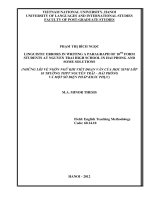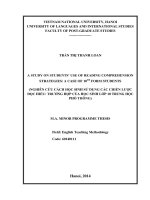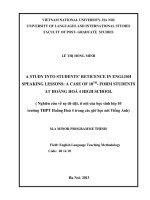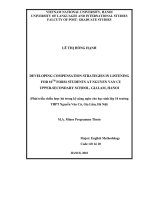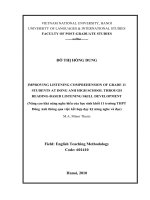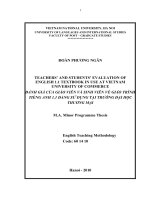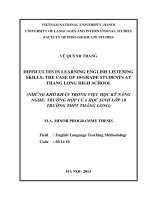Linguistic errors in writing a paragraph of 10th form students at Nguyen Trai high school in Hai Phong and some solutions = Những lỗi về ngôn ngữ khi viết đoạn
Bạn đang xem bản rút gọn của tài liệu. Xem và tải ngay bản đầy đủ của tài liệu tại đây (297.59 KB, 19 trang )
VIETNAM NATIONAL UNIVERSITY, HANOI
VIETNAM NATIONAL UNIVERSITY, HANOI
UNIVERSITY OF LANGUAGES AND INTERNATIONAL STUDIES
UNIVERSITY OF LANGUAGES AND INTERNATIONAL STUDIES
FACULTY OF POST-GRADUATE STUDIES
FACULTY OF POST-GRADUATE STUDIES
PHẠM THỊ BÍCH NGỌC
PHẠM THỊ BÍCH NGỌC
LINGUISTIC ERRORS IN WRITING A PARAGRAPH OF 10TH FORM
LINGUISTIC ERRORS IN WRITING A PARAGRAPH OF 10TH FORM
STUDENTS AT NGUYEN TRAI HIGH SCHOOL IN HAI PHONG AND
STUDENTS AT NGUYEN TRAI HIGH SCHOOL IN HAI PHONG AND
SOME SOLUTIONS
SOME SOLUTIONS
(NHỮNG LỖI VỀ NGÔN NGỮ KHI VIẾT ĐOẠN VĂN CỦA HỌC SINH LỚP
10 TRƯỜNG THPT NGUYỄN TRÃI – HẢI PHÒNG
VÀ MỘT SỐ BIỆN PHÁP KHẮC PHỤC)
(NHỮNG LỖI VỀ NGÔN NGỮ KHI VIẾT ĐOẠN VĂN CỦA HỌC SINH LỚP
10 TRƯỜNG THPT NGUYỄN TRÃI – HẢI PHÒNG VÀ MỘT SỐ BIỆN PHÁP
M.A. KHẮC PHỤC)
MINOR THESIS
M.A. MINOR THESIS
Field: English Teaching Methodology
Code: 60.14.10
Field: English Teaching Methodology
Code: 60.14.10
HANOI - 2012
HANOI - 2012
VIETNAM NATIONAL UNIVERSITY, HANOI
UNIVERSITY OF LANGUAGES AND INTERNATIONAL STUDIES
FACULTY OF POST-GRADUATE STUDIES
PHẠM THỊ BÍCH NGỌC
LINGUISTIC ERRORS IN WRITING A PARAGRAPH OF 10TH FORM
STUDENTS AT NGUYEN TRAI HIGH SCHOOL IN HAI PHONG
AND SOME SOLUTIONS
(NHỮNG LỖI VỀ NGÔN NGỮ KHI VIẾT ĐOẠN VĂN CỦA
HỌC SINH LỚP 10 TRƯỜNG THPT NGUYỄN TRÃI – HẢI PHÒNG
VÀ MỘT SỐ BIỆN PHÁP KHẮC PHỤC)
M.A. MINOR THESIS
Field: English Teaching Methodology
Code: 60.14.10.
Supervisor: Cao Thúy Hồng, M.A.
HANOI - 2012
TABLE OF CONTENT
Page
PART I: INTRODUCTION
1. Rationale
1
2. Objectives of the study
2
3. Research questions
2
4. Scope of the study
2
5. Method of the study
2
6. Organization of the study
2
PART II: DEVELOPMENT
Chapter I: Literature review
I.1. Teaching writing
I.1.1. Reasons for teaching writing
4
I.1.2.. Principles of teaching writing
5
I.2. Teaching paragraph writing
I.2.1. Definition of Paragraph
5
I.2.2. Classifications of paragraph
6
I.3. Writing errors
I.3.1. Definitions of errors
7
I.3.2. The role of “errors” in English Language Teaching
8
I.3.3. Classifications of writing errors
9
I.3.4. Error correction
10
I.3.5. Teacher‟s role in error correction
10
I.4. Previous studies
11
Chapter II: Methodology
II.1. The situation of teaching and learning English at N.T.H.S
12
II.2. Subjects
13
II.3. Research method
13
II.3.1. Method of data collection
13
II.3.2. Method of data analysis
14
II.4. Research procedure
14
Chapter III: Data analysis and discussions
III.1. Students‟ perception of their linguistics errors in writing a paragraph.
1
15
III. 2. Students‟ feeling when making errors in writing
15
III.3. The causes of students‟ linguistic errors in writing a paragraph
16
III.4. Teacher‟s errors correction in students‟ paragraphs
16
III.5. Students‟ revision on their errors
17
III.6. Kinds of linguistic difficulties
18
III. 7. Grammar difficulties
18
III.8. Vocabulary difficulties
21
III.9. Linking words difficulties
23
Conclusion
23
Chapter IV: Suggestions
IV.1. Fostering students‟ knowledge of grammar, vocabulary and linking words.
27
IV.1.1. Fostering students‟ grammar knowledge
27
IV.1.2. Fostering students‟ vocabulary knowledge
28
IV.1.2. Fostering students‟ knowledge of linking words
31
IV.2.1. Self - correction and peer – correction
33
IV.2.2. Teacher‟s correction
35
PART III: CONCLUSION
37
References
39
2
PART I: INTRODUCTION
1. Rationale
Teaching and learning a foreign language aims at providing the learners with
means of communication. To acquire the communicative competence, four
language skills (reading, speaking, listening and writing) are taught regularly at
schools and universities, among which writing skill is very important because it
helps learners to learn other skills better.
“First, writing reinforces the grammatical structures, idioms, and vocabulary
that we have been teaching our students. Second, when they write, they have a
chance to be adventurous with the language, to go beyond what they have just
learned to say, to take risks. Third, when students write, they necessarily become
very involved with the new language; the effort to express ideas and constant use of
eye, hand and brain is the unique way of expressing their idea. They discover a real
need for finding the right word and the right sentence. The close relationship
between writing and thinking makes writing a valuable part of any language
courses” (Raimes, 1938: 3).
Due to the importance of writing skill, it is part of the English syllabus at high
school. However, from the writer‟s teaching-experience at Nguyen Trai high school,
not enough attention has been paid to the teaching and learning of writing skill at
high school. Writing is both dismal and neglected: many students never get a
writing assignment, and many writing exercises in the textbook are abandoned.
Besides that, teachers are also afraid of teaching writing skill. They think that
teaching writing is really a challenge.
The ignorance of writing skill at high school has resulted in students‟ poor
writing skill: they have a lot of mistakes and many of them are unable to write an
understandable paragraph. One of the most serious problems that the writer has
identified from her experience teaching paragraph writing to students is linguistic
difficulties. For example students often use wrong verb tenses in a paragraph, they
confuse the meaning of the words or they can‟t create the coherence in the
paragraph by linking words. Therefore, the researcher would like to do this research
3
to find out common linguistic difficulties in writing a paragraph of 10th form
students and suggest some solutions to help students to avoid the linguistic errors
and improve their paragraph writing.
2. Objectives of the study
As just mentioned, students at Nguyen Trai high school face many linguistic
difficulties in writing a paragraph. Therefore, the ultimate goal of the research is to
find out the real situation of students‟ linguistic difficulties in writing.
3. Research questions
Specifically, the research aims at finding out the answers to the following
questions :
- What are students’ perceptions of their linguistic errors in writing
paragraph?
- What are common linguistic errors (in terms of grammar, vocabulary and
linking words) made by students in writing a paragraph?
4. Scope of the study
The study is about paragraph writing of 10th form students at Nguyen Trai
high school. However, due to the limited scope and time, it is confined to finding
out the students‟ linguistic errors in paragraph writing. Specifically, only mistakes
in grammar, vocabulary and linking words will be taken into consideration.
5. Method of the study
In this study, the writer adopted the quantitative research approach.
Specifically, survey questionnaires and model analysis were two methods employed
to collect data for the research study.
Questionnaires were conducted among 60 students to find out students‟
perceptions of their linguistic difficulties in writing a paragraph.
Sixty paragraphs on three different topics from 60 students were collected.
Mistakes were identified and classified into different categories. Statistical counting
was carried out to bring about the real picture of students‟ linguistic difficulties.
6. Organization of the study
4
In order to achieve the above mentioned aims, this paper is divided into three
parts:
The first part is the Introduction, which points out the rationale, aims, and
scope of the study. Research questions are also specifically defined to serve as
guidelines for the whole paper.
The second part is the Development. In this part, three chapters are
presented. In chapter one, literature related to teaching writing, paragraph writing
and writing errors is reviewed. In chapter two, the method of the study is presented.
It includes careful descriptions of the subjects, sampling method, instrument and
method of data collection and analysis. The last chapter presents data analysis and
discussion. In this part, questionnaires and writing samples collected from 10th form
students at Nguyen Trai high school are analyzed to find out students‟ typical errors
in order to recommend effective strategies for teaching paragraph writing.
The last part of the study is the Conclusion, which points out what has been
addressed as well as what has not been completed and offers recommendations for
further study.
5
PART II: DEVELOPMENT
CHAPTER I: LITERATURE REVIEW
I.1.Teaching Writing
I.1.1. Reasons for teaching writing
I.1.2. Principles of teaching writing
I.2. Teaching paragraph writing
I.2.1. Definitions of Paragraph
I.2.2. Classifications of paragraph
I.3. Writing errors
I.3.1. Definition of errors
I.3.2. The role of "errors" in English Language Teaching
I.3.3. Classification of written errors
I.3.4. Error correction
I.3.5. Teacher‟s role in error correction
I.4. Previous studies
6
CHAPTER II: METHODOLOGY
In this chapter, the author describes the situation of teaching and learning
English at N.T.H.S, the subjects of the study, data collection instruments,
research method and the research procedure.
II.1. The situation of teaching and learning English at N.T.H.C
When these students enter N.T.H.S, they have to take part in exams in three
subjects: Maths, Literature, and English at the beginning of the school year. They
often gain high scores in Maths and Literature but most of them get low scores in
English. All students at lower secondary schools have learned English for four years
but most of them have not paid any attention to learning it. Thus, it is very difficult
for teachers at N.T.H.S to teach them English because the new English textbooks at
high schools now are written based on the English textbooks at lower secondary
schools. Teachers have no time to re-teach all the English knowledge students have
learned at lower secondary schools. They have to follow the syllabus. Day by day,
both teachers and students feel tired and bored when having to teach and learn
English. During the teaching period at N.T.H.S, the researcher sees that, among four
language skills, writing is the most difficult for students. She often hears students
rumbling, teachers avoiding such meticulous task of teaching and learning writing.
Linguistic difficulties in writing a paragraph is one of the big problems in writing
skill.
II.2. Subjects
The subjects of the study consist of 60 students of 10th form at N.T.H.S. Because
of time limitation, it is impossible to carry out the study with all students who are in
grade 10th at N.T.H.S individually. Therefore, the data collection in the study is
derived from a subset of the population by means of cluster sample.
60 students from classes 10C1, 10C4, 10C9, and 10C10 were randomly selected
from 450 the tenth form students at N.T.H.S. Obviously, it was difficult to select a
random sample of individuals because the tenth form students have already been
assigned to different classes from 10C1 to 10C10 and classified into two groups
according to their choice of favorite subjects (students from 10C5 to 10C10 are
interested in natural science subjects whereas 10C1 to 10C4 are basic classes).
7
Therefore, the researcher decided to randomly choose four classes from two groups
to study. The result, thus, could be more reliable.
The 10th form students at N.T.H.S are learning basic English with the new text
book TIENG ANH 10 by Hoàng Văn Vân – Hoàng Thị Xuân Hoa - Đỗ Tuấn MinhNguyễn Thu Phương - Nguyễn Quốc Tuấn. This text book is theme- based, which
includes 16 units and 6 Test Yourself sections. Each unit has its own topics and is
divided into 5 sections: Reading, Speaking, Listening, Writing and Language Focus.
In the first term of the school-year, in comparison with other subjects, students‟
English results were not good: only 4% students got excellent mark (9-10), 12%
got good mark (7-8) , 57% got average mark (5-6) and 27% students got bad marks
(<5).
II.3. Research method
II.3.1. Method of data collection: In order to conduct the study, the researcher
employed quantitative method including questionnaires and students‟ writing
analysis.
a. Questionnaires:
The questionnaire is designed to find out students‟ perception of their
linguistic errors in writing a paragraph, the causes of the errors, the
correction of the errors, the students‟ revision on the errors.
The questionnaire helps the researcher gather information quickly and
objectively and gather information from a large portion of a group.
b. Students’ writing analysis:
The analysis of students‟ writing aims at finding the real situation of the
linguistic errors in students‟ writing. This analysis helps the researcher
classify the major linguistic errors in students‟ writing, compare them with
the result from the questionnaire to come to an agreement of the linguistic
errors students often make.
II.3.2. Method of data analysis
Data from questionnaires was calculated and summarized to identify the
general trends of students‟ linguistic errors when writing a paragraph
Students‟ writing samples were carefully studied. Errors were classified into
different categories to help researcher find out the most common linguistics errors
made by 10th form students.
8
Whenever relevant, data from two sources were compared and contrasted to
have the most comprehensive picture of the situation.
II.4. Research procedure
The procedure of data collection was as follow:
(1) Choosing 60 students who are in grade 10 of N.T.H.S randomly to conduct the
survey of the study.
(2) Giving topics to students to write English paragraphs. The subjects were
required to write about one of the following topics:
a. Write about your daily life
b. Write about your class’s excursion
c. Write about the film that you like best.
There are several reasons to choose the topics. Firstly, these topics are
familiar with students. They are taken from students‟ textbook. Moreover, there are
some guidance as well as some exercises in the textbook for students before writing.
Secondly, students have chance to choose the topic that they are interested in, so
they can write the paragraph with their own ideas basing on the topic they like
(3) Collecting students‟ writing. Students‟ errors in the writings are counted and
categorized.
(4) Synthesizing the analysis and drawing conclusions.
(5) Suggesting some implications for teaching and learning paragraph writing to
10th form students.
CHAPTER III: DATA ANALYSIS AND DISCUSSIONS
This section discusses students‟ perception of their linguistic errors, the
causes of the errors, the correction of the errors, the students‟ revision on the errors
and a classification of difficulties based on the students‟ writing and the
questionnaire.
III.1. Students’ perception of their linguistics errors in writing a paragraph.
Students themselves recognized their weaknesses in writing a paragraph and
they were aware of the linguistic errors they often make when writing.
III. 2. Students’ feeling when making errors in writing
9
After making errors when writing a paragraph, the proportion of students who
were disappointed with their English seemed to be equal to those who consider
making errors the chance to know what they have lacked and to get experience. In
other words, 10th form students at N.T.H.S had a positive attitude towards learning
English. There were only 4 out of 60 students who had negative attitude toward
learning English, they had no feeling when making errors.
III.3. The causes of students’ linguistic errors in writing a paragraph
The percentage of the carelessness cause was the least, then came to teaching
methods cause. The percentage of students who thought that difficult topics cause
the errors was slightly higher. A large number of students thought that the lack of
necessary knowledge was the main cause of the linguistic errors in their writing.
III.4. Teacher’s errors correction in students’ paragraphs
Most teachers chose the common errors to correct. Besides, it was unexpected
that there were many teachers who only gave comment at the end of the paragraph.
A small portion represented those who corrected all errors.
III.5. Students’ revision on their errors
The portion of students who looked carefully the errors and self-corrected
them and those who compared the work with the others and corrected the errors
together were too small, in comparison with those students who had a look at the
remarks given by the teacher - with highest portion. Furthermore, 23% of students
said that they only glanced over indicated errors, and smaller portion of them
(9%)only paid attention to the mark.
III.6. Kinds of linguistic difficulties
There are a lot of linguistic errors that are found and counted in 60 paragraph
writings. However, within the scope of this study, only errors in grammar,
vocabulary and linking words are studied.
There is an agreement between linguistic errors found in students‟ writing
and their awareness of those errors.
10
As can be seen from the table, the most common errors belong to grammar,
which appeared on all the analyzed papers. In the answers for the questionnaire, the
number of students who often had grammatical errors is also the highest. The next
common errors are vocabulary ones which appeared in 41% of students‟ writing
and in the result of questionnaire, 34% of all students recognized that they often
make vocabulary errors. Errors in the linking words seem to be fewer than the
others with only 9% in the writing; and 10% of all students revealed in the
questionnaire that errors in linking words was the most common kind of linguistic
errors they often made.
III. 7. Grammar difficulties
Although students knew that the most common errors they often made was
grammar errors, there was a conflict between the errors students made in their
paragraphs and their perception of those errors. It might be because students
couldn‟t distinguish clearly their grammatical errors.
In students‟ writing, the total number of errors related to the choice of English
tense amounts to 35 (37%) . A large number of the students made errors in this area.
Errors of article usage follows with 34%. Subject-verb agreement is also difficult for
the students in paragraph writing, and accounts for 26%. The least frequently found
errors was preposition usage with 8%.
However, in the result of the questionnaires, a large number of students (43%)
said that they often made errors in using article. Preposition usage and verb tenses
also caused many difficulties for students. Both account for about 24%. Subjectverb agreement did not seem to be difficult for students with 9%.
III.8. Vocabulary difficulties
The table shows differences between the vocabulary errors that students made
in their paragraphs and their perceptions of those errors. In the students‟ writing, the
number of spelling errors was the biggest - 31 mistakes were counted in 60 writing
papers (38%). It was followed by errors in word order, word choice and word form.
However, in students‟ answers in the questionnaires, 46% of students said that word
form is the most difficult. Besides, 33% of students found spelling of the words
11
difficult and 13% of students couldn‟t choose the correct words for their paragraphs.
At last, 8% of students had difficulties in arranging the words into the correct order
in a paragraph.
III.9. Linking words difficulties
The portion of students who often used linking words (11%) was too
small in comparison with the portion of those who sometimes used linking words
(85%). Moreover, a small percentage of students (4%) never paid attention to
linking words in writing a paragraph. In summary, the survey questionnaire revealed
that 10th form students at N.T.H.S did not use linking words regularly in their
paragraph.
Students perceive exactly the aspect of linking words they often make errors.
Nearly two third of students (61%) thought that linking word‟s meaning is the most
difficult and in their writing, most of the errors related to linking words is about
meaning. A small portion of students paid attention to the punctuation of linking
words (17%) and the usage of linking words (22%). Analysis of students‟ writing
shows roughly the same percentage (34% of the errors with linking words are those
related to usage of linking words).
Linking words are very important in writing a paragraph. Without linking
words, the writing is confusing and illogical because ideas in the paragraph are
unconnected together. However, in their compositions, 10th form students face
many problems in connecting the idea smoothly by using linking words. In some
paragraphs, students didn‟t use any linking words each sentence seemed to discuss a
topic. Therefore, it was difficult to decide what the topic of the paragraph is.
Considering the level of students, the author believes all of them have been taught
and they do understand linking words like “since”, “because”, “although”,
“however”, etc. However, their failure of choosing appropriate linking words to
connect sentences reveals that they were still ambiguous about these linking words.
Conclusion
After collected data has been analyzed, it can be seen that the 10th form
students at N.T.H.S were weak at paragraph writing and they made many linguistic
12
errors. Linguistics errors were found in all pieces of writing including errors in
grammar, vocabulary and linking words.
Basing on these findings, in the chapter that follows, the researcher is going
to suggest some better way to teach and learn paragraph writing at NTHS.
„
13
CHAPTER IV: SUGGESTIONS TO THE PROBLEM
IV.1. Fostering students’ knowledge of grammar, vocabulary and linking
words.
IV.1.1. Fostering students’ grammar knowledge
Teaching verb tenses: Verb tenses challenge most students. When studied in
isolation, a given verb tense is clearly understood, but when put into actual use, one
verb tense is easily confused with others. Therefore, teacher should do a
comprehensive review of verb tenses for students. It can be particularly helpful to
show how all the tenses within one timeframe to highlight the relation of one verb
tense to the others.
IV.1.2. Fostering students’ vocabulary knowledge
Helping students to remember the words’ spelling: As teachers we need to
take this into account and find ways of helping students to combat the effects of
memory decay and give them the tools to improve their retrieval ability. We also
need to think of ways to make the experience of learning vocabulary more
memorable
and
of
recycling
the
information
that
we
teach.
IV.1.3. Fostering students’ knowledge of linking words
Teaching the meaning of linking words
Teacher can also teach the meanings of transition words in the context of
transition categories. Teachers have students read passages that use different
transition categories and discuss. Then teachers ask students to complete a cloze
procedure, using those same passages.
Fostering students’ memory of linking words
Step 1
Teacher selects three linking words from each of nine categories and prints
them out on individual cards. Then teacher gives these to the students with the task
of putting the words together that served a similar purpose.
Step 2
Students have to place these linking words correctly into authentic English
sentences teacher printed out on one A4 page each. Teacher simply puts the pages
14
around the room and had students walk around with one or two words per person,
trying
to
find
the
correct
spaces
for
them.
Step 3:The final step is for students to write one sentence themselves with a linking
word left out. Students then read out these sentence with a blank and the whole
class would come up with possible fillers..
IV.2. Helping students to revise the writings and to correct the errors
IV.2.1. Self - correction and peer – correction
Sometimes, teachers need to give students chances for self - correction and
peer-correction because using self-correction or peer-correction can reduce the load
of teacher‟s work of dealing with errors. It also provides students with a chance to
improve their language, their ability of analysis and their habits of coordinativeworking, so the better students can help the weaker ones.
IV.2.2. Teacher’s correction
Obviously, students‟ errors are so various that the teacher cannot correct all
errors because of limited time and numerous students. Teachers need not to be an
over-corrector, that is, point outs and corrects all errors detected. Instead, they can
employ the following techniques to deal with errors.
Firstly, with each set of student papers, there is no point in trying to mark all
the errors. It is advisable that teachers decide in advance what kinds of errors they
are going to deal with.
Secondly, it is important for teachers to bear in mind that errors are to be
examined carefully. Careful analysis of the cause of errors is required in this case.
Thirdly, teachers should first and foremost search for what students have done
correctly.
15
PART III: CONCLUSION
1. Recapitulation
In this study, the major issues concerning students‟ linguistic errors in
writing a paragraph have been taken into consideration and examined both
theoretically and practically. Of all grammar errors, errors in verb tenses are the
most common. Meanwhile in vocabulary use, spelling errors account for the highest
percentage. Besides that, students find it most difficult to understand the meaning of
linking words when using them. Students were aware of the errors they made. In
their perception, they all thought that grammar was the most difficult, and then
vocabulary and linking words. However, with some specific types of linguistic
errors, there was a conflict between students‟ perceptions and the errors they made
in writing for example, the errors in verb tenses, articles, word order and word form.
Students didn‟t recognize exactly which type of grammar errors, vocabulary errors
they often made, or which aspect of linking devices caused difficulty for them.
Students were probably not aware of the differences between the specific kinds of
errors. In students‟ writing correction, teachers only corrected some remarkable
errors only or gave a comment at the end of the paragraph only, which were difficult
for students to recognize their errors. In addition, many students didn‟t revise their
writing so they couldn‟t learn from their own errors and couldn‟t improve their
writing. So teachers should apply a suitable ways in teaching the aspect of grammar,
vocabulary and linking words as well as in correcting students‟ errors, so that the
students can avoid those errors and improve their paragraph writing.
2. Limitations of the study
Due to the limitation of time, references and ability, in the study,
shortcomings are inevitable. Firstly, the study just collected 60 papers from 60
students in N.T.H.S for error analysis. That is only a small number. Therefore, the
results of the research may not be generalized. Secondly, the data for analysis were
paragraphs which were collected from free-writing tasks, students could write the
paragraphs at home, so they could have avoided the structures or words which they
felt uncertain, or they could probably looked for reference or copied from
16
somewhere. This means that the results of the research may not reflect and detect
thoroughly all kinds of errors which the students may commit. However, the
researcher hopes that the study will be a valuable reference and useful to the
teachers and the students in N.T.H.S as well as others who are interested in the
problem.
3. Suggestions for further studies
This research only examined the most common linguistic errors, not all kinds
of errors in paragraph writing. Further studies, therefore, could continue with other
types of errors in paragraph writing. Besides, this research only focuses on
linguistic errors in the teaching and learning of writing. Problems in teaching and
learning other skills could be the topic for further research as well.
17


